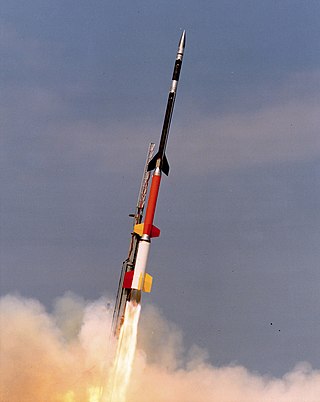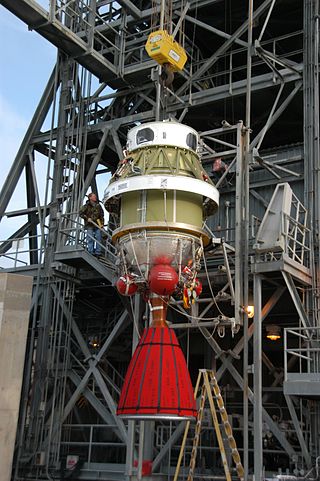Related Research Articles

The Black Brant is a family of Canadian-designed sounding rockets originally built by Bristol Aerospace, since absorbed by Magellan Aerospace in Winnipeg, Manitoba. Over 800 Black Brants of various versions have been launched since they were first produced in 1961, and the type remains one of the most popular sounding rockets. They have been repeatedly used by the Canadian Space Agency and NASA.

Black Arrow, officially capitalised BLACK ARROW, was a British satellite carrier rocket. Developed during the 1960s, it was used for four launches between 1969 and 1971, all launched from the Woomera Prohibited Area in Australia. Its final flight was the first and only successful orbital launch to be conducted by the United Kingdom, and placed the Prospero satellite into low Earth orbit.

The RL10 is a liquid-fuel cryogenic rocket engine built in the United States by Aerojet Rocketdyne that burns cryogenic liquid hydrogen and liquid oxygen propellants. Modern versions produce up to 110 kN (24,729 lbf) of thrust per engine in vacuum. Three RL10 versions are in production for the Centaur upper stage of the Atlas V and the DCSS of the Delta IV. Three more versions are in development for the Exploration Upper Stage of the Space Launch System and the Centaur V of the Vulcan rocket.

Titan IIIB was the collective name for a number of derivatives of the Titan II ICBM and Titan III launch vehicle, modified by the addition of an Agena upper stage. It consisted of four separate rockets. The Titan 23B was a basic Titan II with an Agena upper stage, and the Titan 24B was the same concept, but using the slightly enlarged Titan IIIM rocket as the base. The Titan 33B was a Titan 23B with the Agena enclosed in an enlarged fairing, in order to allow larger payloads to be launched. The final member of the Titan IIIB family was the Titan 34B which was a Titan 24B with the larger fairing used on the Titan 33B.

Monica is the designation of a small French sounding rocket. It was intended as a cheaper counterpart to the relatively expensive Veronique rockets.
Luna E-1 No.3, sometimes identified by NASA as Luna 1958C, was a Soviet spacecraft which was lost in a launch failure in 1958. It was a 361-kilogram (796 lb) Luna E-1 spacecraft, the third of four to be launched, all of which were involved in launch failures. It was intended to impact the surface of the Moon, and in doing so become the first man-made object to reach its surface.

The RD-170 is the world's most powerful and heaviest liquid-fuel rocket engine. It was designed and produced in the Soviet Union by NPO Energomash for use with the Energia launch vehicle. The engine burns kerosene fuel and LOX oxidizer in four combustion chambers, all supplied by one single-shaft, single-turbine turbopump rated at 170 MW (230,000 hp) in a staged combustion cycle.

The Atlas III was an American orbital launch vehicle, used in the years between 2000 and 2005. It was developed from the highly successful Atlas II rocket and shared many components. It was the first member of the Atlas family since the Atlas A to feature a "normal" staging method, compared to the previous Atlas family members, which were equipped with two jettisonable outboard engines on the first (booster) stage. The Atlas III was developed further to create the Atlas V, which still flies to this day.
Luna E-3 No.1, sometimes identified by NASA as Luna 1960A, was a Soviet spacecraft which was lost in a launch failure in 1960. It was a 279-kilogram (615 lb) Luna E-3 spacecraft, the first of two to be launched, both of which were lost in launch failures. It was intended to fly around the Moon on a circumlunar trajectory in order to image the surface of the Moon, including the far side. The E-3 spacecraft were similar in design to the E-2A which had been used for the earlier Luna 3 mission. However, they carried higher resolution cameras, and were intended to make closer flybys.
Luna E-6 No.8, sometimes identified by NASA as Luna 1965A, was a Soviet spacecraft which was lost in a launch failure in 1965. It was a 1,422-kilogram (3,135 lb) Luna Ye-6 spacecraft, the seventh of twelve to be launched, It was intended to be the first spacecraft to perform a soft landing on the Moon, a goal which would eventually be accomplished by the final Ye-6 spacecraft, Luna 9.
Luna E-6LS No.112, sometimes identified by NASA as Luna 1968A, was a Soviet spacecraft which was lost in a launch failure in 1968. It was a 1,700-kilogram (3,700 lb) Luna E-6LS spacecraft, the second of three to be launched. The spacecraft was intended to enter Selenocentric orbit, where it would study the Moon, and demonstrate technology for future crewed Lunar missions.

This comparison of orbital launch systems lists the attributes of all individual rocket configurations designed to reach orbit. A first list contains rockets that are operational or in development as of 2022; a second list includes all retired rockets. For the simple list of all conventional launcher families, see: Comparison of orbital launchers families. For the list of predominantly solid-fueled orbital launch systems, see: Comparison of solid-fueled orbital launch systems.

Transtage, given the United States Air Force designation SSB-10A, was an American upper stage used on Titan III rockets, developed by Martin Marietta and Aerojet.

The AJ10 is a hypergolic rocket engine manufactured by Aerojet Rocketdyne. It has been used to propel the upper stages of several launch vehicles, including the Delta II and Titan III. Variants were and are used as the service propulsion engine for the Apollo command and service module, in the Space Shuttle Orbital Maneuvering System, and on the European Service Module – part of NASA's Orion spacecraft.

The H–I or H–1 was a Japanese liquid-fuelled carrier rocket, consisting of a licence-produced American first stage and set of booster rockets, and all-Japanese upper stages. The H in the name represented the use of liquid hydrogen fuel in the second stage. It was launched nine times between 1986 and 1992. It replaced the N-II, and was subsequently replaced by the H-II, which used the same upper stages with a Japanese first stage.

The Titan IIIA or Titan 3A was an American expendable launch system, launched four times in 1964 and 1965, to test the Transtage upper stage which was intended for use on the larger Titan IIIC. The Transtage was mounted atop two core stages derived from the Titan II. The Titan IIIA was also used as the core of the Titan IIIC.

The Titan 23G, Titan II(23)G, Titan 2(23)G or Titan II SLV was an American expendable launch system derived from the LGM-25C Titan II intercontinental ballistic missile. Retired Titan II missiles were converted by Martin Marietta, into which the Glenn L. Martin Company, which built the original Titan II, had merged. It was used to carry payloads for the United States Air Force (USAF), NASA and National Oceanic and Atmospheric Administration (NOAA). Thirteen were launched from Space Launch Complex 4W (SLC-4W) at the Vandenberg Air Force Base between 1988 and 2003.

The Athena I, known as the Lockheed Launch Vehicle (LLV) at the time of its first flight and Lockheed Martin Launch Vehicle (LMLV) at the time of its second flight, was an American small expendable launch system which was used for four launches between 1995 and 2001. It is a member of the Athena family of rockets, along with the larger Athena II.

The Athena II is an American small expendable launch system which was used for three launches between 1998 and 1999, and which was scheduled to return to service in 2012 but has not been flown again as of October 2022. It is a member of the Athena family of rockets, along with the smaller Athena I.
The RD-864 is a Soviet liquid propellant rocket engine burning UDMH and nitrogen tetroxide in a gas generator combustion cycle. It has a four combustion chambers that provide thrust vector control by gimbaling each nozzle in a single axis ±55°. It is used on the third stage of the R-36M UTTKh and Dnepr. For the R-36M2, an improved version, the RD-869 was developed.
References
- ↑ Krebs, Gunter D. "Rook Family". Gunter's Space Page. Retrieved 2023-09-06.
- ↑ Wade, Mark. "RAF Jaguar". Encyclopedia Astronautica. Retrieved 2023-09-06.
- 1 2 Wade, Mark. "Jaguar 1". Encyclopedia Astronautica. Retrieved 2023-09-06.
- 1 2 Wade, Mark. "Jaguar 2". Encyclopedia Astronautica. Retrieved 2023-09-06.
- 1 2 Wade, Mark. "Jabiru 3". Encyclopedia Astronautica. Retrieved 2023-09-06.
- 1 2 3 4 5 6 7 Serra, Jean-Jacques (2012-10-21). "Jaguar/Jabiru vehicles". Rockets in Europe. Archived from the original on 2012-10-21. Retrieved 2023-09-06.